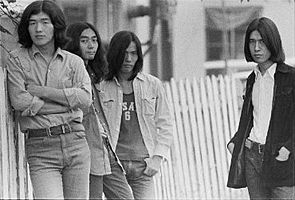Happy End (band) facts for kids
Quick facts for kids
Happy End
|
|
|---|---|

Happy End in September 1971. From left to right: Eiichi Ohtaki, Haruomi Hosono, Shigeru Suzuki and Takashi Matsumoto.
|
|
| Background information | |
| Also known as | Blue Valentine |
| Origin | Chiyoda, Tokyo, Japan |
| Genres | Folk rock, psychedelic rock |
| Years active | 1969–1972 1973, 1985, 2015 |
| Labels | URC, Bellwood/King |
| Associated acts | Tin Pan Alley, Nobuyasu Okabayashi, Apryl Fool |
| Past members | Haruomi Hosono Eiichi Ohtaki Shigeru Suzuki Takashi Matsumoto |
Happy End (Japanese: はっぴいえんど, Hepburn: Happī Endo) was a Japanese folk rock band that played music from 1969 to 1972. The band had four talented members: Haruomi Hosono, Takashi Matsumoto, Eiichi Ohtaki, and Shigeru Suzuki. Their music was very new and different for Japan at that time, almost like it was from the future! Many people think Happy End is one of the most important bands in Japanese music history. MTV even said their music was "rock with psych smudges around the edges," which means it had a cool, dreamy, and unique sound.
Who Were Happy End?
Happy End was a group of four friends who loved making music. They came together in 1969 in Chiyoda, Tokyo, Japan. Each member brought something special to the band.
- Haruomi Hosono played the bass guitar. He also helped write many of their songs.
- Takashi Matsumoto was the drummer. He was also the main lyricist, meaning he wrote all the words for their songs.
- Eiichi Ohtaki played the guitar and sang. He had a unique voice that fans loved.
- Shigeru Suzuki played the guitar too. His guitar playing added a special touch to their sound.
Together, these four musicians created a sound that was unlike anything else in Japan at the time.
How Happy End Started
Before Happy End, Haruomi Hosono and Takashi Matsumoto were in a band called Apryl Fool. After that band broke up, they decided to start something new. They wanted to create music that was truly Japanese. They teamed up with Eiichi Ohtaki and Shigeru Suzuki, and Happy End was born.
At this time, many Japanese bands tried to sound like Western rock bands. They often sang in English. Happy End had a different idea. They wanted to sing in Japanese, using everyday language. This was a big step for Japanese music. It showed that rock music could be sung in their own language and still be cool.
Their Unique Sound
Happy End's music is often called folk rock and psychedelic rock. What do these terms mean?
- Folk rock mixes traditional folk music with rock and roll. It often uses acoustic guitars and tells stories in the lyrics.
- Psychedelic rock is a style of rock music that tries to copy the feeling of being in a dream or having strange visions. It often uses special guitar effects and sounds.
Happy End blended these styles in a special way. Their songs had catchy melodies and thoughtful lyrics. But they also added dreamy, sometimes strange, sounds that made their music feel very new. This mix was considered "avant-garde" in Japan. "Avant-garde" means something that is very new and experimental, often ahead of its time. People weren't used to hearing rock music like this, especially sung in Japanese.
Why Happy End Was Important
Even though Happy End was only active for a few years, they left a huge mark on Japanese music. Here's why they are so important:
- Singing in Japanese: They proved that rock music could be powerful and popular when sung in Japanese. This opened the door for many other Japanese bands to sing in their native language.
- Pioneering Sound: Their unique blend of folk and psychedelic rock inspired many musicians who came after them. They showed that Japanese artists could create their own original sound, not just copy Western bands.
- Influence on Future Artists: Many famous Japanese musicians and bands have said that Happy End was a big influence on their work. They helped shape the sound of Japanese rock music for decades.
After Happy End broke up in 1972, the members went on to have very successful solo careers. They continued to make amazing music and influence new generations of artists. They also reunited a few times over the years for special performances, showing their lasting bond and the timeless appeal of their music.

